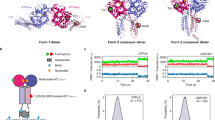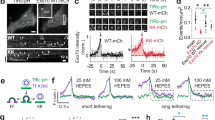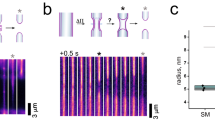Abstract
Fusion and fission drive all vesicular transport. Although topologically opposite, these reactions pass through the same hemi-fusion/fission intermediate1,2, characterized by a ‘stalk’ in which only the outer membrane monolayers of the two compartments have merged to form a localized non-bilayer connection1,2,3. Formation of the hemi-fission intermediate requires energy input from proteins catalysing membrane remodelling; however, the relationship between protein conformational rearrangements and hemi-fusion/fission remains obscure. Here we analysed how the GTPase cycle of human dynamin 1, the prototypical membrane fission catalyst4,5,6, is directly coupled to membrane remodelling. We used intramolecular chemical crosslinking to stabilize dynamin in its GDP·AlF4−-bound transition state. In the absence of GTP this conformer produced stable hemi-fission, but failed to progress to complete fission, even in the presence of GTP. Further analysis revealed that the pleckstrin homology domain (PHD) locked in its membrane-inserted state facilitated hemi-fission. A second mode of dynamin activity, fuelled by GTP hydrolysis, couples dynamin disassembly with cooperative diminishing of the PHD wedging, thus destabilizing the hemi-fission intermediate to complete fission. Molecular simulations corroborate the bimodal character of dynamin action and indicate radial and axial forces as dominant, although not independent, drivers of hemi-fission and fission transformations, respectively. Mirrored in the fusion reaction7,8, the force bimodality might constitute a general paradigm for leakage-free membrane remodelling.
This is a preview of subscription content, access via your institution
Access options
Subscribe to this journal
Receive 51 print issues and online access
$199.00 per year
only $3.90 per issue
Buy this article
- Purchase on Springer Link
- Instant access to full article PDF
Prices may be subject to local taxes which are calculated during checkout




Similar content being viewed by others
References
Chernomordik, L. V. & Kozlov, M. M. Mechanics of membrane fusion. Nature Struct. Mol. Biol. 15, 675–683 (2008)
Kozlov, M. M., McMahon, H. T. & Chernomordik, L. V. Protein-driven membrane stresses in fusion and fission. Trends Biochem. Sci. 35, 699–706 (2010)
Frolov, V. A. & Zimmerberg, J. Cooperative elastic stresses, the hydrophobic effect, and lipid tilt in membrane remodeling. FEBS Lett. 584, 1824–1829 (2010)
Schmid, S. L. & Frolov, V. A. Dynamin: functional design of a membrane fission catalyst. Annu. Rev. Cell Dev. Biol. 27, 79–105 (2011)
Ferguson, S. M. & De Camilli, P. Dynamin, a membrane-remodelling GTPase. Nature Rev. Mol. Cell Biol. 13, 75–88 (2012)
Morlot, S. & Roux, A. Mechanics of dynamin-mediated membrane fission. Annu. Rev. Biophys. 42, 629–649 (2013)
Cohen, F. S. & Melikyan, G. B. The energetics of membrane fusion from binding, through hemifusion, pore formation, and pore enlargement. J. Membr. Biol. 199, 1–14 (2004)
Lee, J. Y. & Schick, M. Calculation of free energy barriers to the fusion of small vesicles. Biophys. J. 94, 1699–1706 (2008)
Kozlovsky, Y. & Kozlov, M. M. Membrane fission: model for intermediate structures. Biophys. J. 85, 85–96 (2003)
Frolov, V. A., Escalada, A., Akimov, S. A. & Shnyrova, A. V. Geometry of membrane fission. Chem. Phys. Lipids 185, 129–140 (2015)
Chappie, J. S., Acharya, S., Leonard, M., Schmid, S. L. & Dyda, F. G. Domain dimerization controls dynamin’s assembly-stimulated GTPase activity. Nature 465, 435–440 (2010)
Chappie, J. S. et al. A pseudoatomic model of the dynamin polymer identifies a hydrolysis-dependent powerstroke. Cell 147, 209–222 (2011)
Gennerich, A. & Vale, R. D. Walking the walk: how kinesin and dynein coordinate their steps. Curr. Opin. Cell Biol. 21, 59–67 (2009)
Ramachandran, R. & Schmid, S. L. Real-time detection reveals that effectors couple dynamin’s GTP-dependent conformational changes to the membrane. EMBO J. 27, 27–37 (2008)
Doose, S., Neuweiler, H. & Sauer, M. Fluorescence quenching by photoinduced electron transfer: a reporter for conformational dynamics of macromolecules. ChemPhysChem 10, 1389–1398 (2009)
Mansoor, S. E., Dewitt, M. A. & Farrens, D. L. Distance mapping in proteins using fluorescence spectroscopy: the tryptophan-induced quenching (TrIQ) method. Biochemistry 49, 9722–9731 (2010)
Faelber, K. et al. Crystal structure of nucleotide-free dynamin. Nature 477, 556–560 (2011)
Ford, M. G., Jenni, S. & Nunnari, J. The crystal structure of dynamin. Nature 477, 561–566 (2011)
Pucadyil, T. J. & Schmid, S. L. Real-time visualization of dynamin-catalyzed membrane fission and vesicle release. Cell 135, 1263–1275 (2008)
Bashkirov, P. V. et al. GTPase cycle of dynamin is coupled to membrane squeeze and release, leading to spontaneous fission. Cell 135, 1276–1286 (2008)
Shnyrova, A. V. et al. Geometric catalysis of membrane fission driven by flexible dynamin rings. Science 339, 1433–1436 (2013)
Sundborger, A. C. et al. A dynamin mutant defines a superconstricted prefission state. Cell Rep. 8, 734–742 (2014)
Mehrotra, N., Nichols, J. & Ramachandran, R. Alternate pleckstrin homology domain orientations regulate dynamin-catalyzed membrane fission. Mol. Biol. Cell 25, 879–890 (2014)
Grafmüller, A., Shillcock, J. & Lipowsky, R. Pathway of membrane fusion with two tension-dependent energy barriers. Phys. Rev. Lett. 98, 218101 (2007)
Risselada, H. J., Bubnis, G. & Grubmüller, H. Expansion of the fusion stalk and its implication for biological membrane fusion. Proc. Natl Acad. Sci. USA 111, 11043–11048 (2014)
Fuhrmans, M. & Müller, M. Coarse-grained simulation of dynamin-mediated fission. Soft Matter 11, 1464–1480 (2015)
Morlot, S. et al. Membrane shape at the edge of the dynamin helix sets location and duration of the fission reaction. Cell 151, 619–629 (2012)
Stowell, M. H., Marks, B., Wigge, P. & McMahon, H. T. Nucleotide-dependent conformational changes in dynamin: evidence for a mechanochemical molecular spring. Nature Cell Biol. 1, 27–32 (1999)
Loo, T. W. & Clarke, D. M. Determining the dimensions of the drug-binding domain of human P-glycoprotein using thiol cross-linking compounds as molecular rulers. J. Biol. Chem. 276, 36877–36880 (2001)
Leonard, M., Song, B. D., Ramachandran, R. & Schmid, S. L. Robust colorimetric assays for dynamin's basal and stimulated GTPase activities. Methods Enzymol. 404, 490–503 (2005)
Neumann, S., Pucadyil, T. J. & Schmid, S. L. Analyzing membrane remodeling and fission using supported bilayers with excess membrane reservoir. Nature Protocols 8, 213–222 (2013)
Edelstein, A., Amodaj, N., Hoover, K., Vale, R. & Stuurman, N. Computer control of microscopes using microManager. Curr. Protoc. Mol. Biol. Chapter 14, Unit 14.20 (2010).
Hömberg, M. & Müller, M. Main phase transition in lipid bilayers: phase coexistence and line tension in a soft, solvent-free, coarse-grained model. J. Chem. Phys. 132, 155104 (2010)
Fuhrmans, M. & Müller, M. Mechanisms of vesicle spreading on surfaces: coarse-grained simulations. Langmuir 29, 4335–4349 (2013)
Español, P. & Warren, P. Statistical mechanics of dissipative particle dynamics. EPL 30, 191 (1995)
Trofimov, S. Y., Nies, E. L. & Michels, M. A. Constant-pressure simulations with dissipative particle dynamics. J. Chem. Phys. 123, 144102 (2005)
Daoulas, K. C. & Müller, M. Comparison of simulations of lipid membranes with membranes of block copolymers. Adv. Polym. Sci. 224, 197–233 (2010)
Hömberg, M. & Müller, M. The role of inertia and coarse-graining on the transverse modes of lipid bilayers. EPL 97, 68010 (2012)
Carr, J. F. & Hinshaw, J. E. Dynamin assembles into spirals under physiological salt conditions upon addition of GDP and gamma phosphate analogues. J. Biol. Chem. 272, 28030–28035 (1997)
Acknowledgements
We thank J. Chappie for helpful discussions, A. Mohanakrishnan and D. Reed for technical assistance. S.L.S. was supported by National Institutes of Health grant R01-GM42455 and the Welch Foundation Grant I-1823. V.A.F. was supported by grants from the Spanish Ministry of Economy and Competitiveness BFU2012-34885, the Basque Government Program Etortek IE12-332 and European FEDER funds. J.E.H. was supported by the National Institute of Diabetes and Digestive and Kidney Diseases Intramural Research Program. M.F. and M.M. were supported by the Volkswagen foundation and the DFG-CRC803 “Functionality controlled by organization in and between membranes” (B03). Simulations were performed at the Jülich Supercomputing Center and the North-German Supercomputer Alliance Hannover/Berlin. J.-P.M. was supported by a postdoctoral research grant from the Academy of Finland.
Author information
Authors and Affiliations
Contributions
J.-P.M. and S.L.S. initiated the project. J.-P.M. designed and generated the CC- and CXC-Dyn1 mutants and performed all of the FRET and PET analysis, as well as their biochemical and functional characterization on liposomes and SUPER templates. A.V.S., E.R.H. and V.A.F. performed the nanotube conductance and GUV experiments. S.N. characterized the P294 mutants. A.C.S. and J.E.H. performed the cryo-EM and negative-stain EM analyses. M.F. and M.M. performed the molecular simulations. All authors discussed and interpreted the experimental data and the results of molecular simulation. S.L.S. and V.A.F. coordinated the project and wrote the manuscript, with considerable contributions from all co-authors who also approved the final version.
Corresponding authors
Ethics declarations
Competing interests
The authors declare no competing financial interests.
Extended data figures and tables
Extended Data Figure 1 Domain structure and biochemical characterization of dynamin constructs.
a, Domain structure of dynamin and cartoon illustrating that the GTPase domain (G domain, blue) connects through the bundle signalling element (BSE), composed of the N- and C-terminal helices of the G domain and the C-terminal helix from GED (yellow) to the stalk formed by the middle domain and GED (magenta). The pleckstrin homology domain (PHD, green) interacts with membrane lipids. b, c, Basal (b) and assembly-stimulated (c) rates of GTP hydrolysis for 0.5 μM WT-Dyn1 and CW-Dyn1 before and after BODIPY conjugation. Data are shown as average ± s.d., n = 3.
Extended Data Figure 2 Role of P294 in BSE conformational dynamics.
a, Changes in emission intensity of BODIPY-labelled CW-Dyn1 and CW-Dyn1(P294A) due to loss of PET after addition of 1 mM GMPPCP. Although the BSE partially opens upon addition of GMPPCP, its movements are constrained relative to wild type by the mutation of P294. b, Assembly-stimulated GTPase activity of 0.5 μM P294A, P294G and P294V Dyn1 measured on 100 nm liposomes relative to WT-Dyn1. The mutants show near wild-type activity, indicating their ability to self-assemble onto and tubulate liposomes (data shown as average ± s.d., n = 4). c, Fission activity of 0.5 μM P294A, P294G and P294V Dyn1 relative to WT-Dyn1 measured as the percentage of total membrane released from SUPER templates during 30 min incubation in the presence of GTP (data shown as average ± s.d., n = 3). Substitution of P294 with the more rigid valine residue has a greater effect on fission activity.
Extended Data Figure 3 Characterization of CxC-Dyn1.
a, Concentration dependence of the specific GTPase hydrolysis rates of WT-Dyn1 (filled squares), CC-Dyn1 (filled circles) and CxC-Dyn1 (open triangles) measured in solution at 1 mM GTP (data shown as average ± s.d., n = 3). b, EM micrographs (representative images from four independently prepared samples) showing CxC-Dyn1 assembled into rings and short spirals (arrows) in the presence of GMPPCP visualized by negative stain. Insets: top view, rings; side view, short spirals (arrows). These rings are reminiscent of those previously observed with WT-Dyn1 only in the presence of transition state nucleotide analogues (for example, GDP·AlF4−)39. Unlike CxC-Dyn1, CC-Dyn1 remained unassembled in the presence of GMPPCP (data not shown). Scale bars, 100 nm.
Extended Data Figure 4 Negative-stain and cryo-EM images of CC- and CxC-Dyn1 assembled onto PS liposomes in the absence of nucleotides.
a, b, Negative-stain (a) and cryo-EM (b) images are shown. Note the disordered nature of CxC-Dyn1 spirals relative to CC-Dyn1 structures seen via negative stain in a. Scale bars, 100 nm. b, Arrow points to relatively ordered CxC-Dyn1 assemblies, while arrowheads point to sparse dynamin assemblies appearing as single or double rings.
Extended Data Figure 5 Altered membrane interactions of the CxC-Dyn1 transition-state conformer.
a, Fluorescence emission spectra of 0.1 μM CC-Dyn1 or CxC-Dyn1 (donor) as well as dansyl-PE (acceptor)-containing liposomes (5 μM total lipid; 90 mol% PS, 10 mol% dansyl-PE) upon excitation at 280 nm. FRET between the PH domain Trp residues and dansyl is evident in the donor plus acceptor samples as a decrease in donor and an increase in acceptor emission. b, Self-assembly of the indicated proteins (1 μM) on liposomes identical to those used in the GTPase assay (300 μM total lipid; Fig. 3f) examined by sedimentation followed by SDS–PAGE analysis of the supernatant (S) and pellet (P) fractions. c, Percentages of proteins pelleted after incubation with or without 400 nm PS liposomes (1 μM protein, 300 μM total lipid) and 1 mM GTP, as indicated, was quantified by sedimentation followed by SDS–PAGE and densitometric analyses of the protein levels in supernatant and pellet fractions (data shown are average ± s.d., n = 3).
Extended Data Figure 6 Coarse-grained approach to modelling localized membrane constriction by CxC-Dyn1.
a, Schematic representation of the geometry of the ring system used to produce local constriction of a prototype membrane tube. Two pairs of rings are shown, each formed by two closely juxtaposed rings (separated by a small distance Δx). The inner ring in each pair has the radius r and the outer ring has a slightly larger radius r+Δr so that the ring pair promotes creation of an hourglass membrane shape. The PHDs of dynamin are represented as amphiphilic disks evenly distributed over the rings with the centre of mass of each disk being restrained to a position on the ring (marked by blue and orange points). Two overlapping disks (purple and brown) attached to the right juxtaposed ring pair are shown. The orientations of the disks are not fixed, so the normal to the disk surface (purple and brown arrows) can have an arbitrary direction. b, Axial cross-section of a stable hemi-fission intermediate, the cylindrical micelle, created by the ring system shown in a. The rectangular box indicates the dimensions of the cylindrical micelles (the diameter D and the length L).
Extended Data Figure 7 Molecular simulations of the hemi-fission and fission transformations.
The red box shows a representative sequence of simulation snapshots (axial cross-sections) demonstrating the formation of the stable hemi-fission intermediate26. Radial constriction of a membrane tube resulted in reversible closure of the tube lumen, that is, flicker26, followed by formation of a stable cylindrical micelle structure. The blue box summarizes the simulation runs exploring the stability of the hemi-fission intermediate and its rupture. The top part shows stable structures corresponding to the constrained intermediate (left, taken at zero tension) and the unconstrained intermediate (right, taken at 0.06 dyn cm−1 tension). The bottom part shows the rupture of the intermediates by 0.6 dyn cm−1 tension (left and right) or by elongation of the ring system at 0.06 dyn cm−1 tension (middle). The characteristic times for the rupture are indicated near the corresponding blue arrows.
Extended Data Figure 8 Dynamin-catalysed membrane fission occurs in two mechanistically distinct stages through a hemi-fission intermediate.
Model overlaying the distinct dynamin activities and conformational changes onto the two energy barriers (green curve) that must be overcome, first to catalyse formation of the metastable hemi-fission intermediate and subsequently to drive full fission. When trapped in the transition state and in the absence of GTP, CxC-Dyn1 can drive the formation of a metastable and flickering hemi-fission state (solid blue curve) through the assembly of small scaffolds and enhanced wedging activity of the PHD. However, without subsequent GTPase-driven conformational changes required to loosen the scaffold, generate axial force and retract the PHD, as occurs for WT-Dyn1 (dotted blue line), the membrane-bound CxC-Dyn1 creates an insurmountable barrier to fission (dashed blue line).
Supplementary information
Addition of CxC-Dyn1 to fluorescently-labeled membrane tethers drawn from SUPER templates.
CxC-Dyn1 assembles onto and constricts the membranes, seen as dark patches, but is unable to mediate membrane fission. Representative of 5 independent experiments. (AVI 4196 kb)
Addition of CC-Dyn1 to fluorescently-labeled membrane tethers drawn from SUPER templates.
CC-Dyn1 assembles onto and constricts the membranes, seen as dark patches, and subsequently catalyzes membrane fission causing the tether to break and retract. Representative of 5 independent experiments. (AVI 1483 kb)
CxC-Dyn1 is preassembled onto and tubulates GUVs in the absence of nucleotide. The movie shows the effect of addition of GTP.
The tubes remain constricted but collapse back in the reservoir indicating GTPase-dependent loosening of the CxC-Dyn1 scaffold. Representative of 3 independent experiments. (AVI 2371 kb)
Rights and permissions
About this article
Cite this article
Mattila, JP., Shnyrova, A., Sundborger, A. et al. A hemi-fission intermediate links two mechanistically distinct stages of membrane fission. Nature 524, 109–113 (2015). https://doi.org/10.1038/nature14509
Received:
Accepted:
Published:
Issue Date:
DOI: https://doi.org/10.1038/nature14509
This article is cited by
-
Dynamin A as a one-component division machinery for synthetic cells
Nature Nanotechnology (2024)
-
Dynamin-dependent vesicle twist at the final stage of clathrin-mediated endocytosis
Nature Cell Biology (2021)
-
Myomerger promotes fusion pore by elastic coupling between proximal membrane leaflets and hemifusion diaphragm
Nature Communications (2021)
-
How does curvature affect the free-energy barrier of stalk formation? Small vesicles vs apposing, planar membranes
European Biophysics Journal (2021)
-
Reconstitution and real-time quantification of membrane remodeling by single proteins and protein complexes
Nature Protocols (2020)
Comments
By submitting a comment you agree to abide by our Terms and Community Guidelines. If you find something abusive or that does not comply with our terms or guidelines please flag it as inappropriate.



